Mushrooms generally grow in temperate climates. They can also live in the desert with out-of-the-ordinary adaptations such as favoring a shaded growing place.
While a rare sight, mushrooms do grow in the desert and they are found in The Americas, Africa, and Australia.
Mostly not edible or even having unknown edibility due to their scarcity, mushrooms of the desert are also found in The United States.
The deserts of the Southwestern United States are home to several mushroom species, some being poisonous.
Many mushrooms in the desert are not edible and are even poisonous. Even more, a considerable percentage of mushrooms in the desert can be lethal.
For example, up to 5% of the mushrooms growing in the 4 deserts in Oman are believed to be deadly even when eaten in small quantities.
Others may be edible but are rarely worth picking due to their scarcity.
Table of Contents
How do mushrooms survive in the desert
Most mushrooms cannot grow in the desert. Their adaptations are atypical and normally involve growing close to food and in areas with at least some moisture.
Looking dried up
Sandy-Stilt Puffball and other types of desert mushrooms have a dried-up appearance. They even look bark-like.
The skin of these mushrooms is thickened and protects them from desiccation. Mushrooms can also have peeling-like skin of the stipe and cap which further protects them from the elements.
Growing close to other vegetation
Cacti, shrubs, and trees are among the vegetation desert mushrooms live around.
Acacia bushes are among the bushes most notably known for the shade and food they provide to American mushrooms of the desert.
This type of shrub offers a shaded place for it to grow while its roots offer nutritional value.
Growing only after the rain
While there are mushrooms that grow throughout the year in the desert, some only do so in the rainy season.
Areas with the highest level of water accumulation where temporary vegetation grows are also the areas of the desert where mushrooms can grow.
Mostly growing as rhizomes
Desert Thumb mushrooms are among the species that are mostly underground rhizomes through almost all of their life cycle.
These mushrooms grow underground feeding on underground decaying vegetation and also enjoying extra moisture.
Having a small cap
A considerable number of mushrooms in the desert survive by growing a small cap about the stipe’s diameter.
A smaller cap also absorbs less heat and can grow in mostly shaded areas among desert bushes.
11 Mushrooms in the Desert
The following species of mushrooms are found in the deserts of the world.
1. Sandy Stilt-Puffball
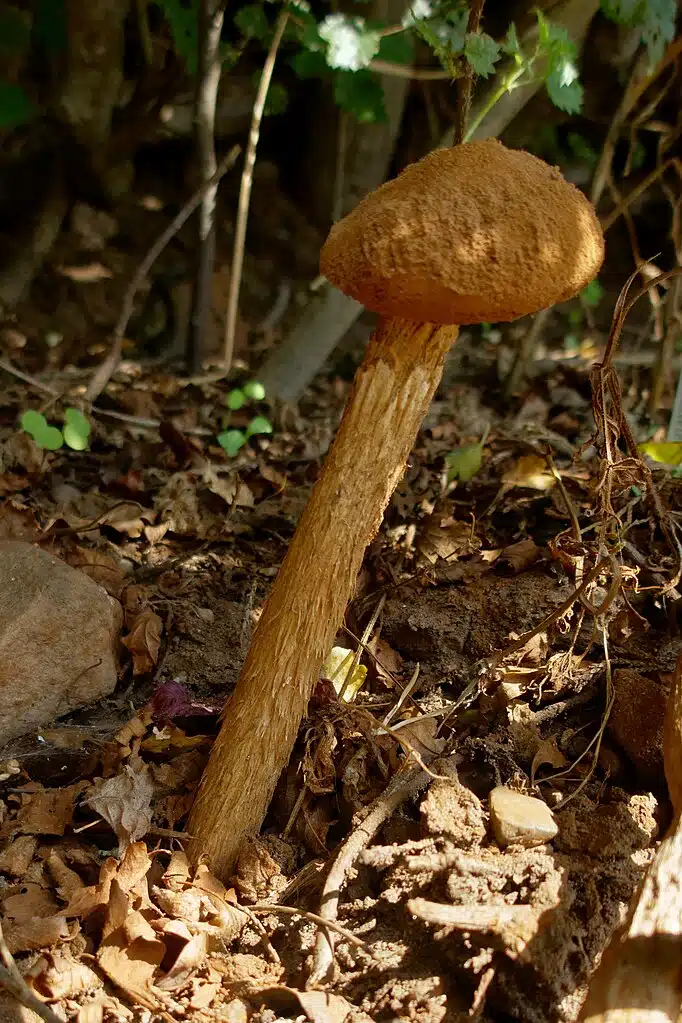
Sandy Stilt-Puffballs (Battarrea phalloides) are tall mushrooms found in Europe, Africa, Australia, Asia, and The Americas.
Some evidence suggests the European species may have slight differences from those in the deserts of the world.
Sandy Stilt-Puffballs grow tall, some even reaching a height of up to 15 inches.
As one of the rarest mushrooms in the world, this is a species often found among the scarce local vegetation in the desert.
It’s not unusual for Sandy Stilt-Puffballs to grow among cacti.
Even more, these mushrooms are well-adapted to the desert climate by looking dead and dry throughout their growth stage.
Local animals may not approach the mushrooms as they seem dead and the mushrooms themselves don’t need to store much water as they have a drier appearance.
These mushrooms aren’t edible and aren’t flavorsome either.
Some states around the world even ban the picking of Sandy Stilt-Puffballs due to their scarcity.
2. Desert Shaggymane
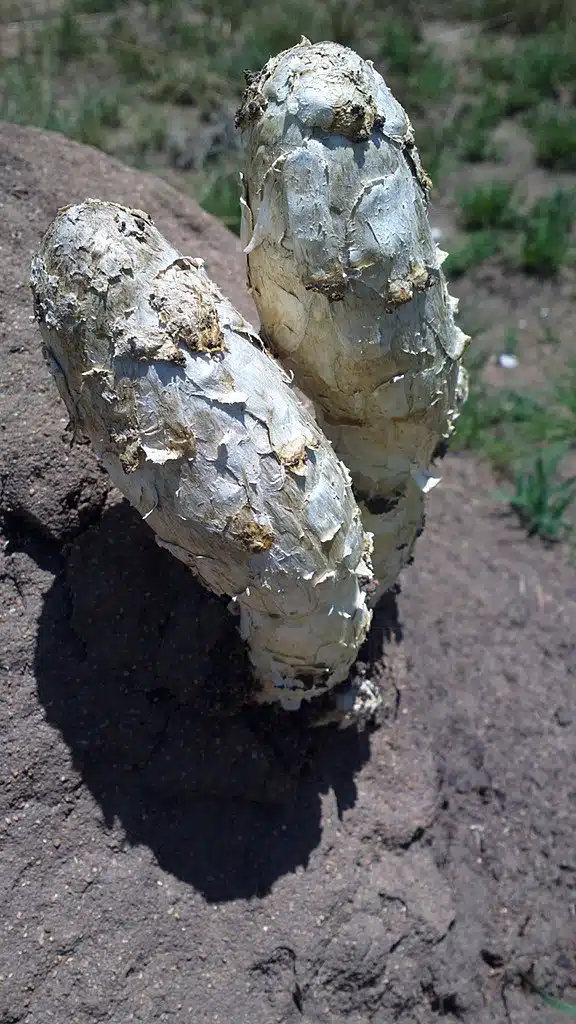
Found in the deserts of Australia and Africa, Desert Shaggymane mushrooms (Podaxis pistillaris) don’t even look like typical mushrooms.
The spread of the species is considerable around world deserts. The Desert Shaggymane also grows in the deserts of California.
This hardy type of mushroom is also found around Las Vegas.
They feature a dried-up appearance, a hard stipe, and a round cap that falls off at maturity releasing the spores for to spread around.
Growing straight out of dunes, these types of mushrooms are mostly spotted after it rains.
They can’t spread considerably in the dry periods.
In local cultures, the species has different uses, mainly outside of eating. According to some reports, these types of mushrooms were used for their antimicrobial action in alternative medicine.
Similar to other mushrooms of the species, Desert Shaggymanes were and still are used as a dye.
Known for their yellow-brown rusty appearance, these mushrooms may be quite tall. In some cases, they reach a height of up to 5.9 inches.
3. Desert Inkcap
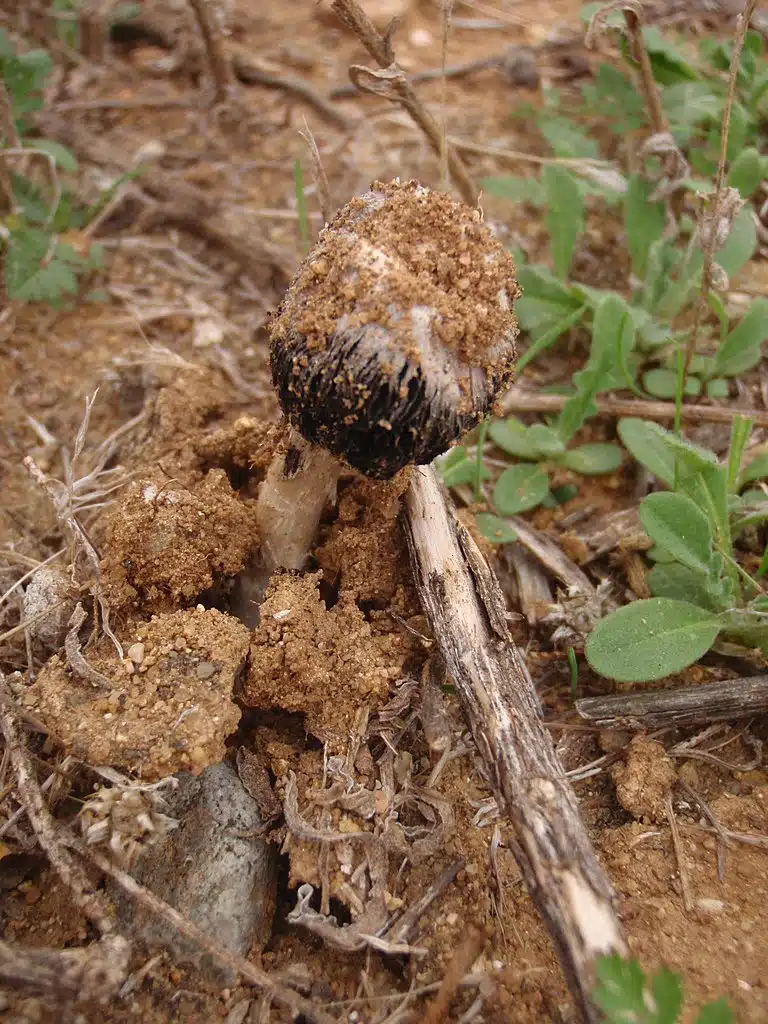
A very rare type of desert mushroom, The Desert Inkcap (Montagnea arenaria) is a species that has a very dark appearance.
Brown and black nuances dominate its appearance. Its cap is even black and dry-looking.
Its dry brown stipe looks like tree bark and completes the overall dry appearance of the species.
Throughout its growth stages, Desert Inkcaps are known for their dry and almost dead-looking appearance.
While they don’t store much water, they grow tall, reaching a size of up to several inches.
Adapted to the deserts of The Americas, Desert Inkcaps can grow on dry land and dunes.
Clay soils and rocky areas of the desert are also suitable for the adaptable mushroom.
Growing straight out of dunes, the mushroom also plays an important role in the desert’s ecosystem as food for local animals.
Its initial coloring resembles the earthy nuances of the dunes while the black and darker brown nuances are developed as the mushroom grows.
Their caps eventually become black.
4. Gasteroid Agaricus
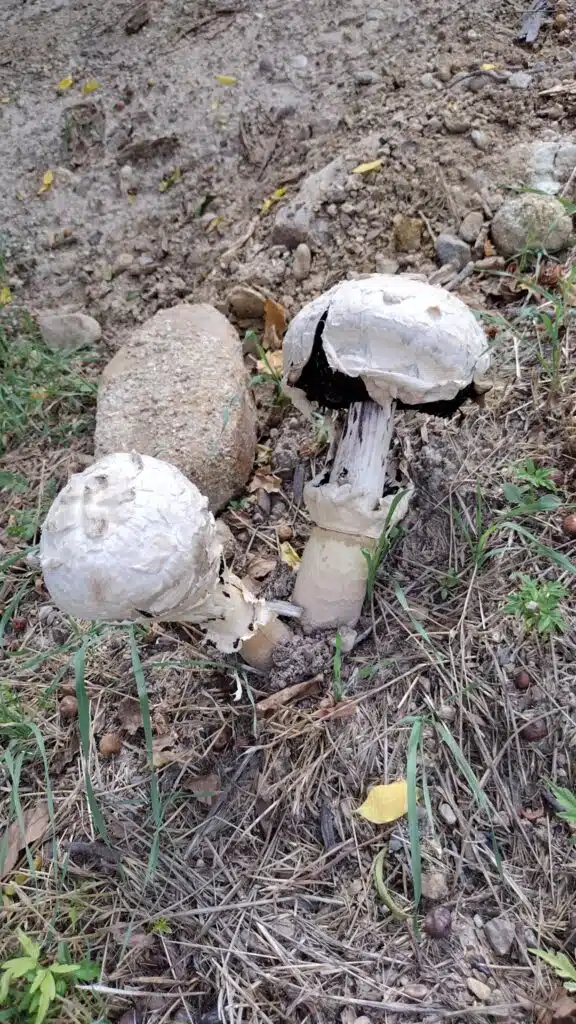
The dry-looking Gasteroid Agaricus (Agaricus deserticola) is a species that also grows in the Southwestern US deserts.
Mushrooms of the species also grow outside of the desert, on grassland, and along roads.
Most reports of the species come from areas around large cities such as those around San Francisco.
The species has a dry-looking egg-shaped cap that doesn’t show any gills.
Tan and brown nuances are specific to this species which grows to a maximum size of just a few inches, with some of the tallest of them measuring up to 7 inches.
Like other desert mushrooms, they feed on decaying vegetation and can grow on different types of soil, including on beach dunes.
These mushrooms spread once the cap (which measures up to 4 inches in diameter) rips and spreads the spores.
Not much is known about the edible status of the species. Official data suggests this is not a species that can be eaten.
On the other hand, reports are showing the mushroom is edible and even tasty.
5. Desert Thumb
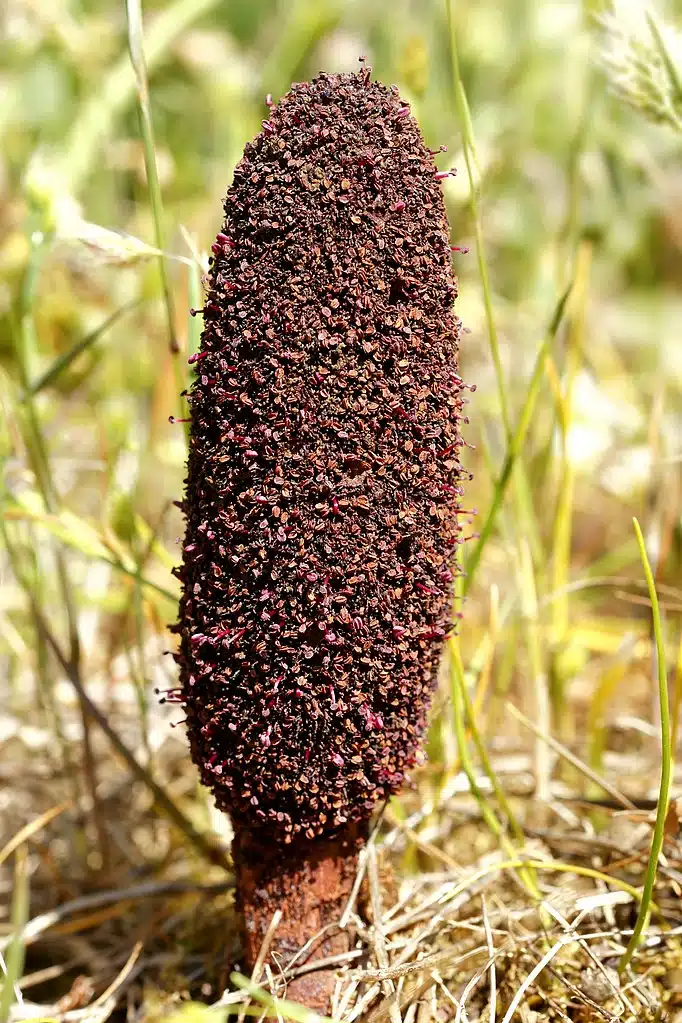
Desert Thumb (genus Cynomorium) are known for their phallic shape and dark inflorescence.
This type of fungi isn’t even seen in its early days which are spent as rhizomes connected to a host plant it feeds on underground.
Its habitat is vast and it also includes deserts.
Many Desert Thumbs grow around The Mediterranean, both in Europe and North Africa.
This is also a species of The Arabian Peninsula and it has a long history in herbal medicine.
Various possible positive attributes have been attributed to Desert Thumbs over the years.
These types of mushrooms have been recommended for irritation and even as a natural cure for erectile dysfunction.
Today, Desert Thumbs may be protected in some areas they grow in.
It also has an unpleasant smell comparable to the smell of rotten cabbages. Flies are attracted to its bad smell which then helps it spread its spores.
6. Corkstar Puffball
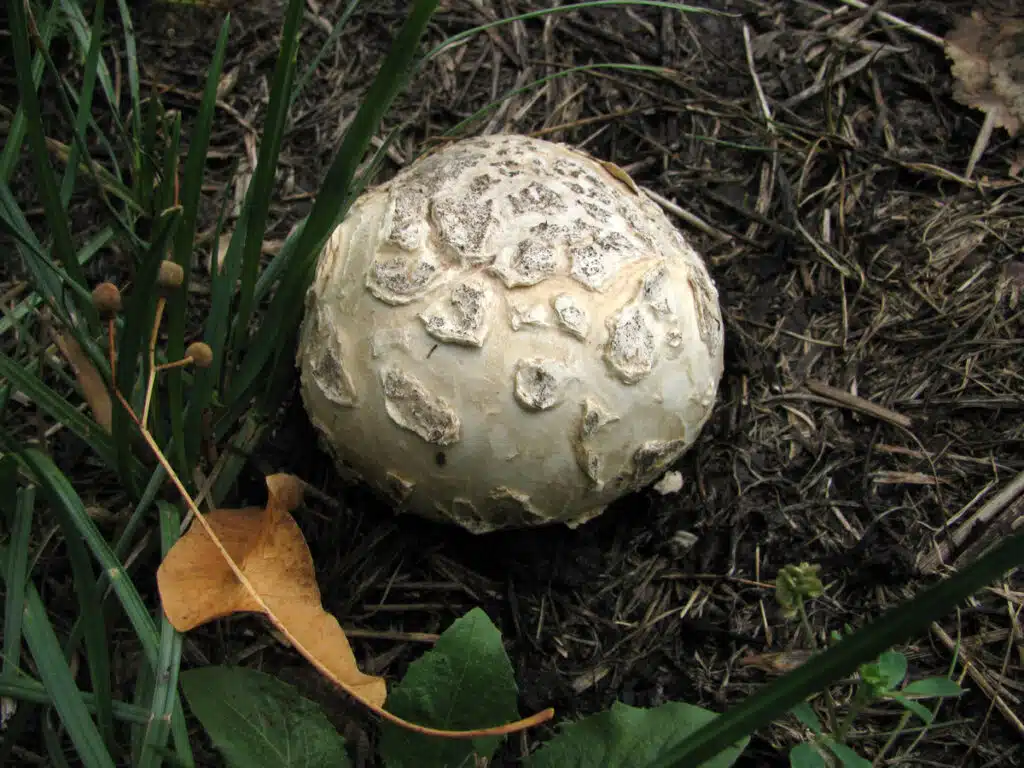
This type of gleba mushroom is found in Australian deserts in the deserts of the Southwestern United States.
It has a globular shape and it grows to a size of around 6 inches.
Much of its appearance is dictated by its growth stages.
The mushroom has a bright, almost completely white appearance before darkening.
Once large enough, it becomes dark brown or even black.
Much of its range within world deserts is limited to areas with other plants as Crockstar Puffballs (Mycenastrum corium) feed on decaying plant matter.
The species is further known for being partly edible. According to some reports, it can be eaten after cooking but only when picked in its white stage.
7. Minor Pouch Agaricus
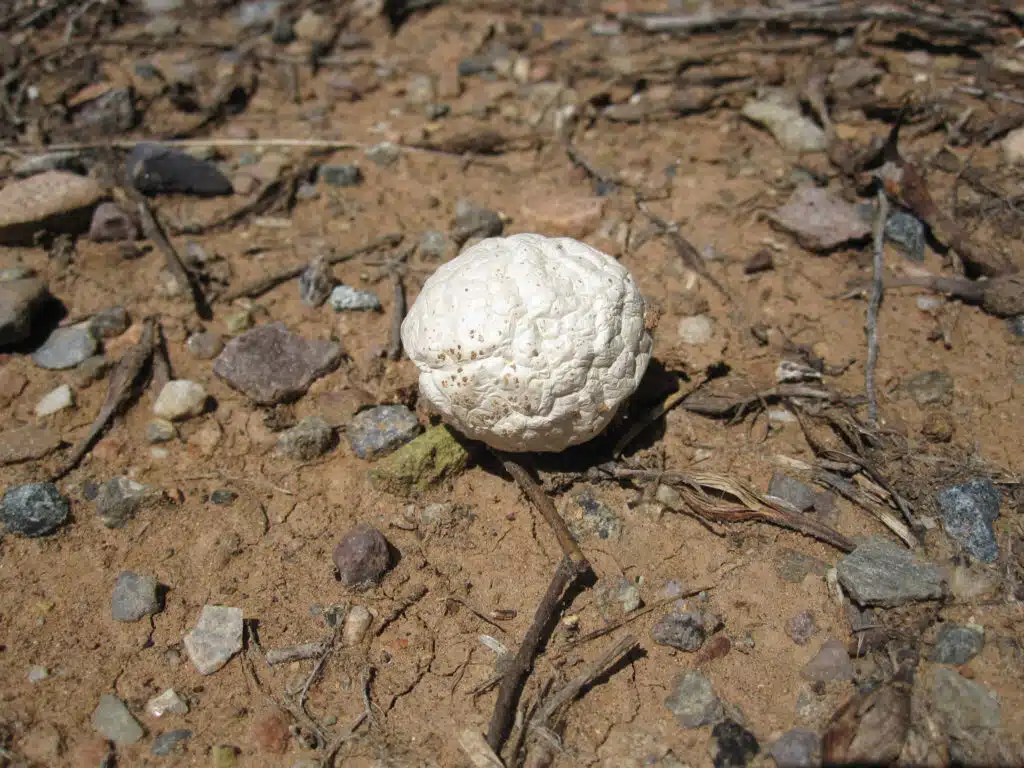
The deserts of the Southwestern United States are areas where the Minor Puch Agaricus mushroom (Agaricus columellatus) has been reported.
This very rare species is rarely found frequently and much of its range is tied to the acacia bush.
Some of the regions of the desert with acacia bush here are the Northernmost limit of the tree species in the world which means the mushrooms are also growing on the scarcely in this limit.
Outside of the desert, Minor Puch Agaricus can also grow on grassland.
A bright appearance is characteristic of the species except the brown-patterned cap which further shows bright margins.
Growing to a diameter of up to 2 inches, it has a white stipe and pink gills that eventually turn black.
The mushrooms in the desert do tend to be darker and drier.
8. Saltshaker Stiltball
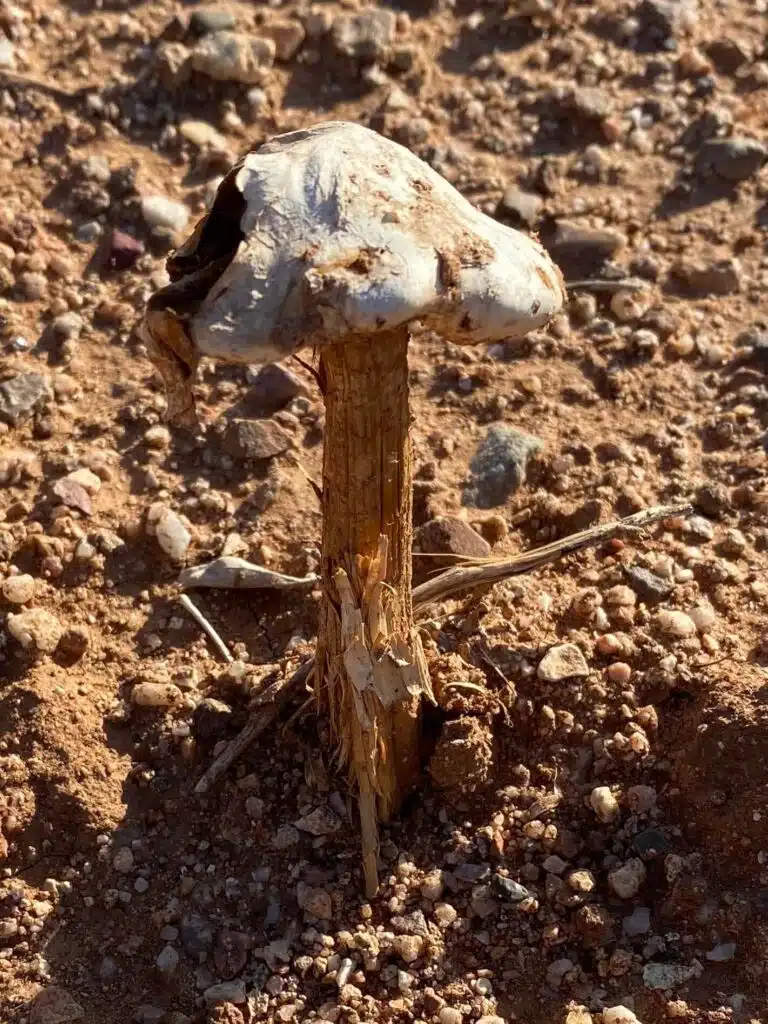
The deserts in the Southwestern United States plus regions of Baja California and North Mexico are areas where Saltshaker Stiltball mushrooms (Battarreoides diguetii) live.
As its name implies, this is a mushroom with an elongated shape and a small cap with a few brown spots which resemble a saltshaker.
A brown dry bark-like stipe is specific to the species which has a brighter type of cream-to-white cap.
Brown spots are seen both on the upper and lower part of the cap.
A general darkening appearance is also spotted on these mushrooms. By the time they are fully grown, they are dominated by brown nuances both on the stipe and on the cap.
One way this species manages to survive the desert is to have a bark-like stipe appearance.
An exfoliating stipe that looks like its dead is a dry stipe that allows this species to live in areas of low humidity.
Outside of the desert regions, these species also grow next to hardwood trees. They are found in areas of Southeastern California with some of them spreading into grassland.
9. Chlamydopus meyenianus
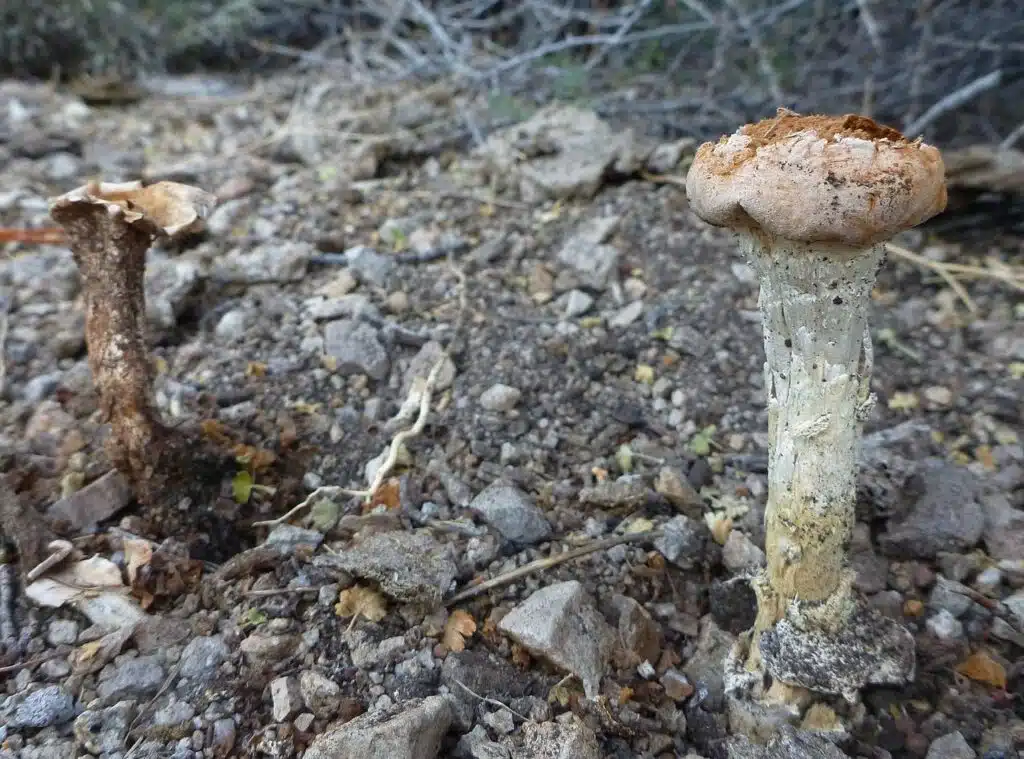
This type of mushroom grows next to the scarce vegetation of the desert. It can survive in sandy soils but also clay soils here.
Chlamydopus meyenianus is a species of American desert that grows in The Mojave Desert and The Atacama Desert.
From low elevation to grows in areas at up to 9.000 feet, the mushrooms are adapted to living in low humidity habitats.
Tan, white, cream, and brown nuances dominate their appearance.
They show a long thin stipe which is darker brown towards the cap. A white cap with a pattern of brown spots is also specific to the species.
One adaptation of this mushroom includes having a very tall stipe but a small cap.
10. Podaxis longii
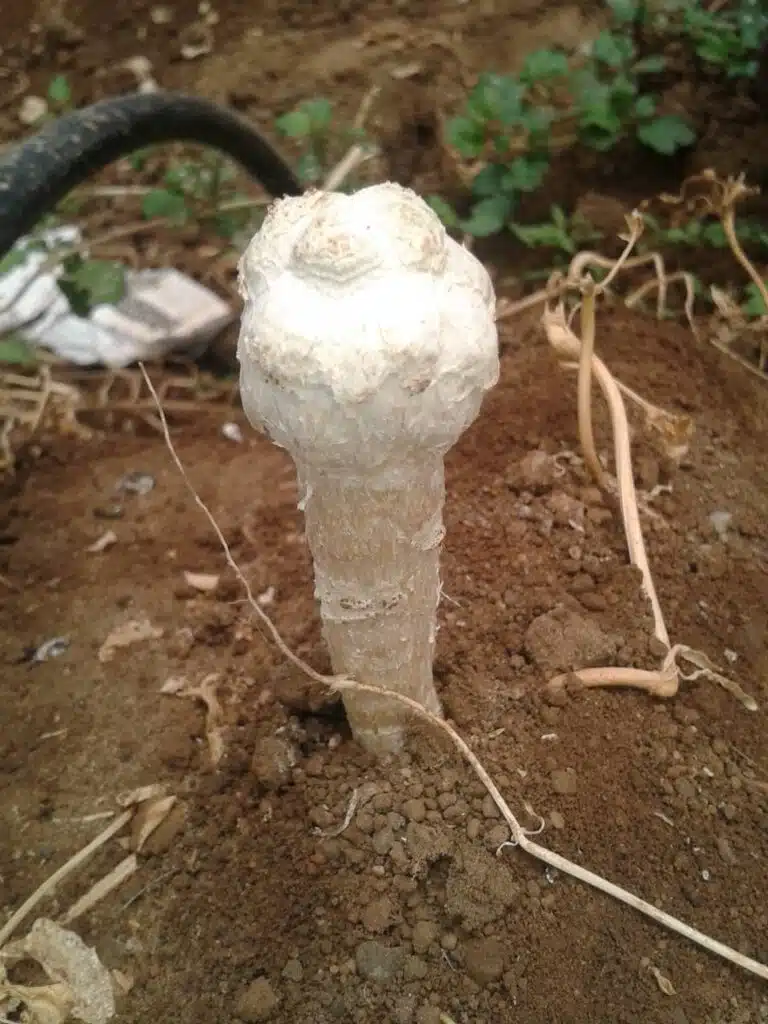
Growing up to a height of 20 inches, this type of mushroom is present in the deserts of The Americas and the arid regions of Central America.
The species is known for its taller cap and shorter stipe. Its cap alone can measure 16 inches.
Much of its growing pattern is tied to existing shrubs and vegetation in the desert as it feeds on it.
The mushroom always grows scarcely but the spores of the species are spread by wing.
The species isn’t believed to be edible in its early days or even as it matures and when it eventually turns brown from an initial white color.
11. Fly Agaric

Fly Agaric mushrooms and their varieties are often found in deserts and the arid regions of The Americas and Australia.
Many varieties of this species are still being disputed but none of them are believed to be edible.
Fly Agaric mushrooms (Amanita muscaria) are considered highly poisonous, with at least several confirmed poisoning cases.
Accidentally eating this mushroom can lead to psychoactive-like reactions.
The mushroom is well-researched and its poisonous profile is turned into a spray that kills insects and flies, as its name implies.